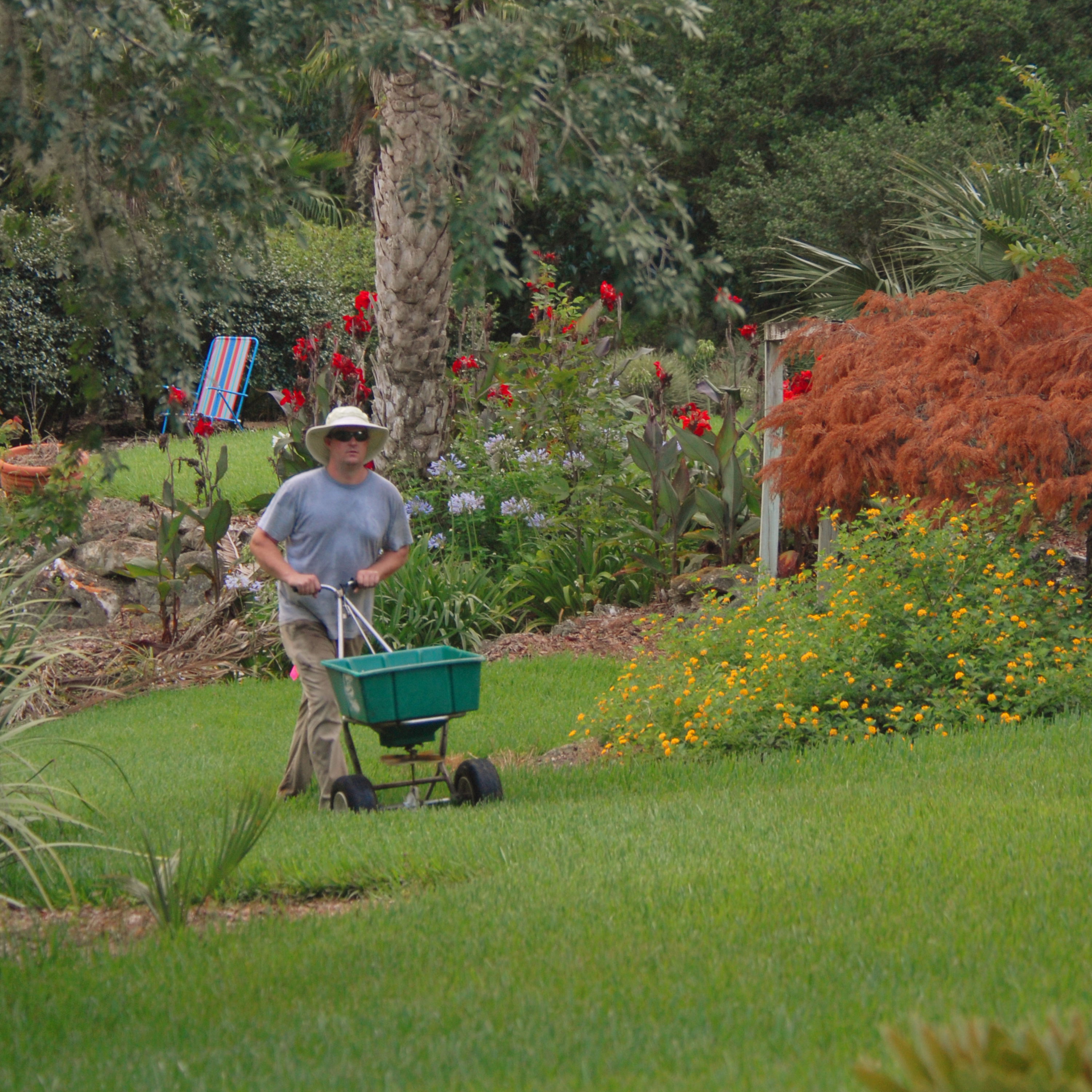
by Sheila Dunning | Jul 21, 2017
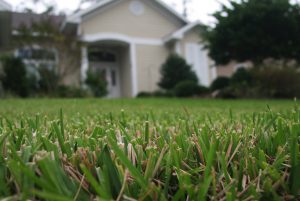
(UF/IFAS photo Thomas Wright)
Northwest Florida’s weather patterns can present challenges to maintaining a health lawn. Heavy rains promote fast growth and relentless sunshine causes lawns to fade. In the last 200 days we have received at least 68 days of rain. While the rest of Florida was experiencing record drought, the Panhandle was experiencing torrential downpours. With every drop of rain your spring fertilizer is being metabolized by the lawn, reducing how many nutrients remain in the soil. Even the best slow-release fertilizer will only last 3-4 months. The message is: “It’s time for more fertilizer.”
A healthy lawn is an important component of the urban landscape. Not only do lawns increase the value of a property, they also reduce soil erosion, filter stormwater runoff, cool the air, and reduce glare and noise. A healthy lawn effectively filters and traps sediment and pollutants that could otherwise contaminate surface waters and groundwater. Lawns require nutrients throughout the growing season to stay healthy. In Northwest Florida the growing season is typically April to October.
Proper fertilization consists of selecting the right type of fertilizer and applying it at the right time and in the right amount for maximum plant uptake. The type of fertilizer should be based on a soil test, available through UF/IFAS Extension. The timing of application and amount of fertilizer is dependent on the research-based recommendations for the grass species and the fertilizer analysis of the product being used.
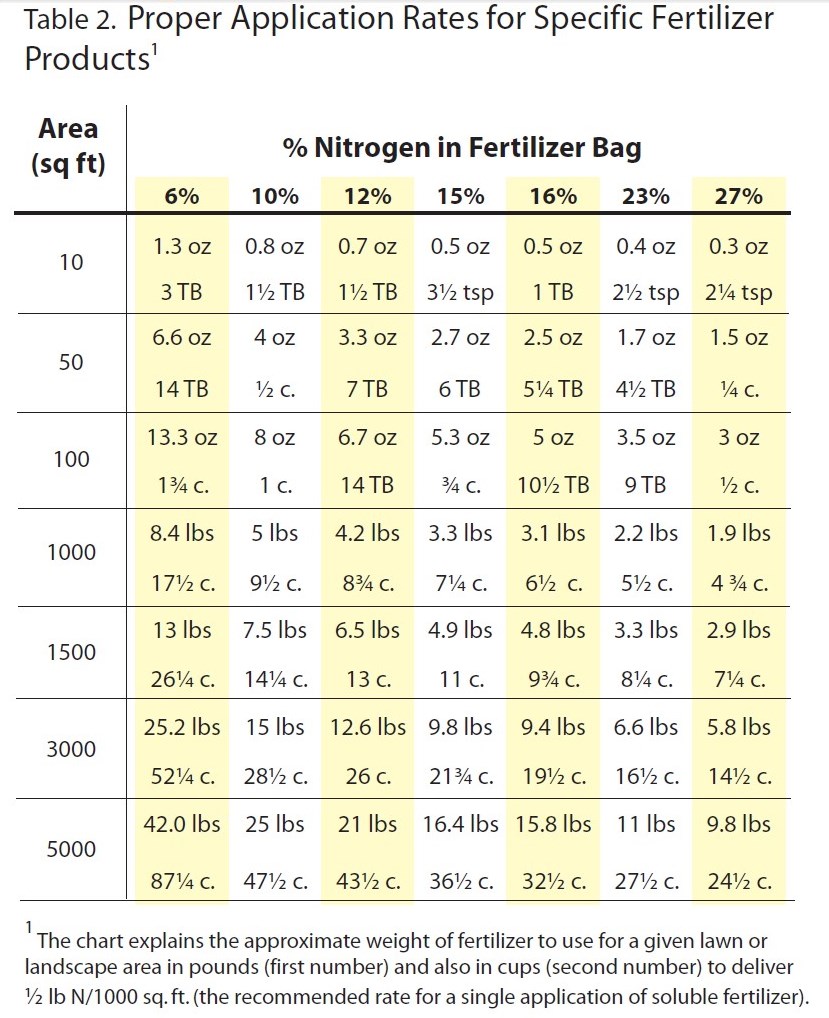
Chart excerpted from Florida Friendly Landscaping publication
Select only a fertilizer that states that the product is for use on residential turf. Do not use a fertilizer meant for flower or vegetable gardens on lawns. By Florida Administrative Code, Rule 5E-1.003, the Urban Turf Rule requires that the fertilizers being applied to residential lawns are labeled for the site and the application rates be followed. Typically, these products will contain both slow-release nitrogen and low or no phosphorus. Slow-release nitrogen will provide a longer-lasting response from the grass and reduces the potential for burning. For more information on the Urban Turf Rule go to: http://www.edis.ifas.ufl.edu/pdffiles/EP/EP35300.pdf.
With frequent rain the soil is also losing iron. Keep in mind that the green fading to yellow appearance in your lawn may be an iron deficiency. Before applying your summer fertilizer put out a liquid chelated iron. It will improve the health of the lawn while you are trying to find a dry day to fertilize. While it is necessary to water in fertilizer with ¼” of water to reduce burn potential and volatilization, never apply fertilizer when heavy rain is expected. The rainfall over ¼” can encourage runoff and/or leaching of that fertilizer, which can be costly and environmentally harmful.
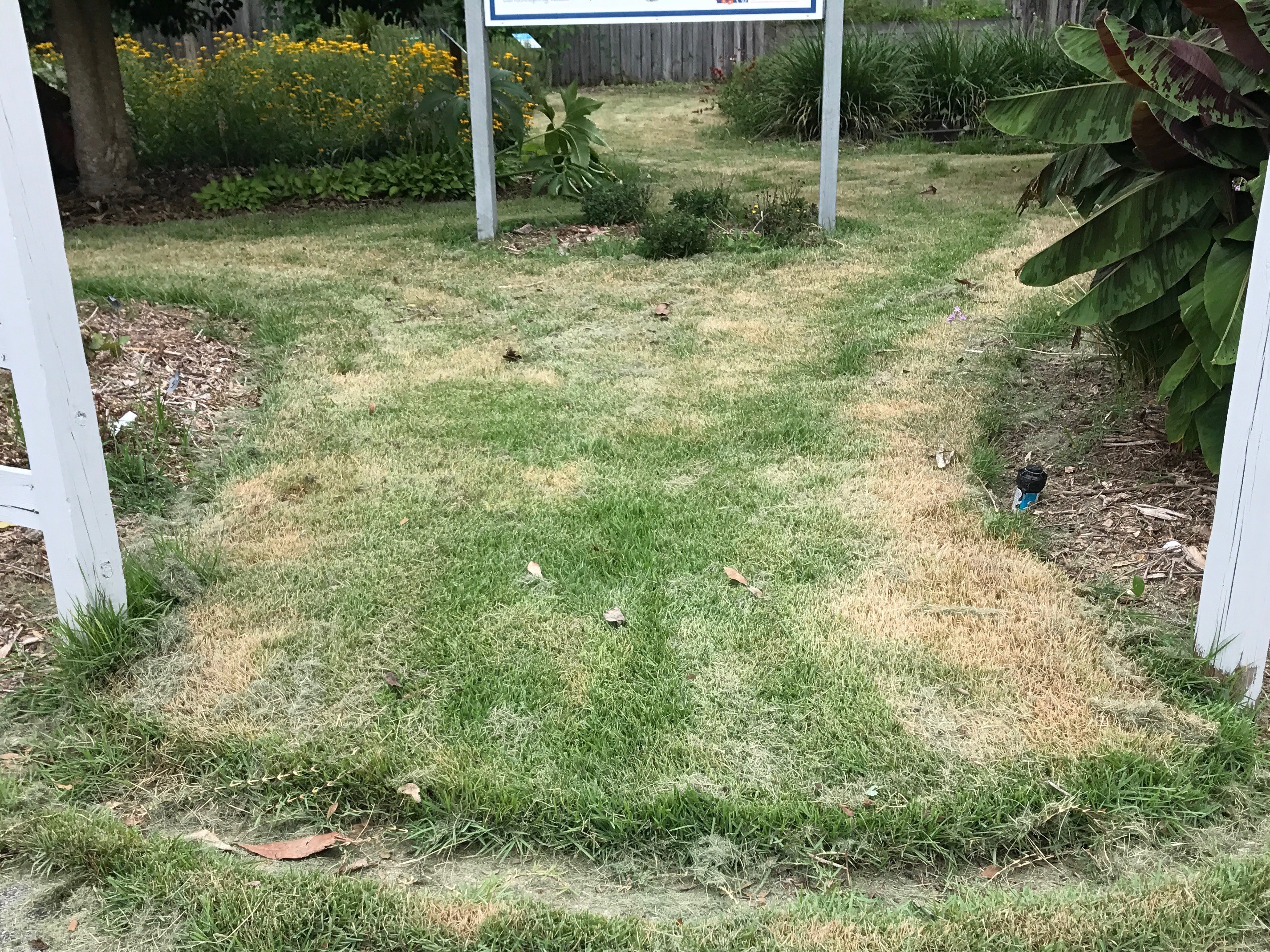
by Blake Thaxton | Jul 21, 2017
Northwest Florida has experienced an enormous amount of rain this summer. The western panhandle has received over 29 inches of rain since the beginning of May according to the Florida Automated Weather Network station at the West Florida Research and Education Center in Jay, Florida. That is 44% of average annual rainfall in less than two months. All of this rain has probably thrown off the normal lawn mowing routine. It is hard to get out and mow the lawn when its pouring buckets or the lawn resembles a swamp. With all of this in mind, there are a couple of mowing pointers that would be useful to implement to address the out of control lawn growth and the challenges posed by not being able to stick to normal mowing schedule.
- Always attempt to mow at the IFAS recommended height for your species of turfgrass. The recommended heights are determined by how quickly the species grow in our climate. The chart below shows the best heights at which to mow your lawn. The fine textured zoysiagrasses are not listed but should be mowed at 0.5 to 1.5 inches. Check the lawn mowers mowing height by measuring the distance from the ground to the bottom of the mowing deck on a flat surface.
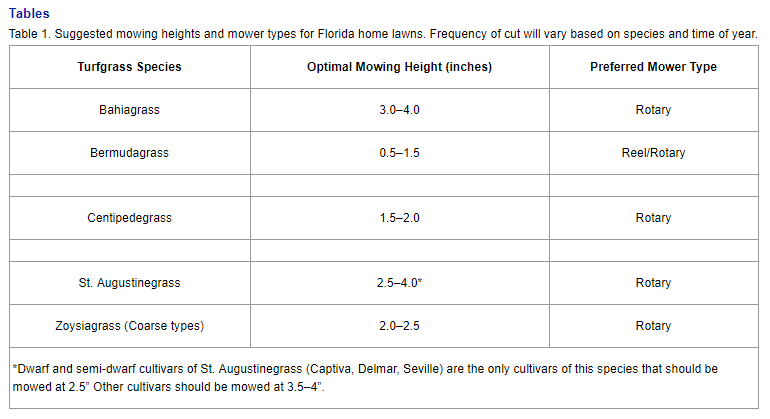
From Mowing Your Florida Lawn: http://edis.ifas.ufl.edu/pdffiles/LH/LH02800.pdf
- When you do get out to mow, never remove more than 1/3 of the leaf blade. If you cut to short you will “scalp” the turf and cause a brown look on the lawn. This can be damaging to the turf and allow for weeds to get established by exposing the soil to the sunlight. What is taking place more in northwest Florida is not mowing frequently enough and cutting off excess growth due to the rain. This also can cause scalping so it is very important to mow frequently enough to only remove 1/3 of the leaf blade.
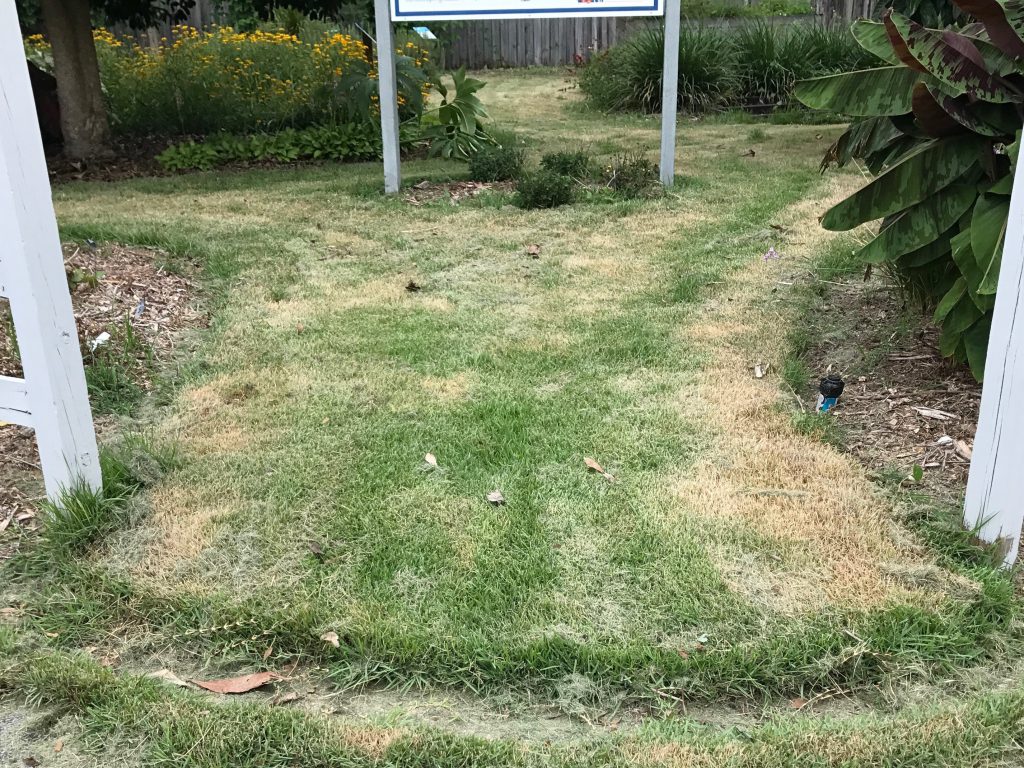
A zoysia lawn that has been “scalped” after excess growth and infrequent mowing. (Photo Credit: Blake Thaxton)
Other practices such as keeping your mower blade sharp, mowing in different directions, and leaving clippings on the ground will help keep a healthy Florida lawn. Please see more information about mowing correctly in Florida in the University of Florida/IFAS Extension publication: Mowing Your Florida Lawn
by Larry Williams | Jul 21, 2017
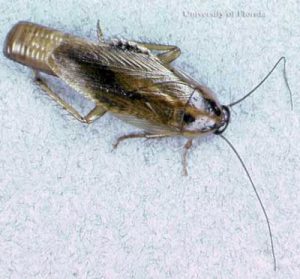
Figure 1. Adult female Asian cockroach, Blattella asahinai Mizukubo, carrying an egg case (ootheca). Photograph by R.W. Baldwin, University of Florida.
The Asian cockroach was first identified as a newly introduced species in the U.S. in Lakeland, Florida in 1986. I started seeing this small cockroach in our area about 17 or 18 years ago. They’ve done well recently with the rains and their numbers are probably higher now as a result. They prefer warm, wet conditions. Populations of 30,000 to 250,000 per acre are reported in some literature.
They are mostly active at night, hiding in mulched landscape beds and lawns during the day. It’s not uncommon to disturb them as you walk through or hand water mulched plant beds during daytime hours. When doing so, the little roaches, which may be mistaken for small moths, quickly fly as they are disturbed.
Asian cockroaches occasionally fly into homes or automobiles at night, attracted to lights. Thankfully, they don’t live long indoors, though.
Control is difficult. Because they can fly 120 feet or more in a single flight, large areas around a home require treatment. And cockroaches in surrounding untreated areas (lawns, mulched plant beds and nearby woods) may result in re-infestation.
Traditional indoor treatments are ineffective because Asian roaches don’t typically live and breed indoors. The best control has been attained by using insecticide baits (labeled for roach control) in infested areas outdoors. Always follow the label directions and precautions when using any pesticide, including insecticides.
Sodium vapor lamps for outdoor lighting and yellow incandescent bulbs for porch lighting are less attractive to the flying adults.
Both the German and Asian cockroach adults are about 5/8 inch long and are brown to dark brown in color with two darker parallel bands running lengthwise just behind their head. But unlike the German cockroach, the Asian cockroach is a strong flier. Even though German cockroaches have wings, they do not fly. Also, unlike the German cockroach, which prefers to live indoors and is a major household pest as a result, the Asian cockroach prefers to live outside.
For more info on this roach species, visit the below UF/IFAS Extension EDIS website.
http://edis.ifas.ufl.edu/in277
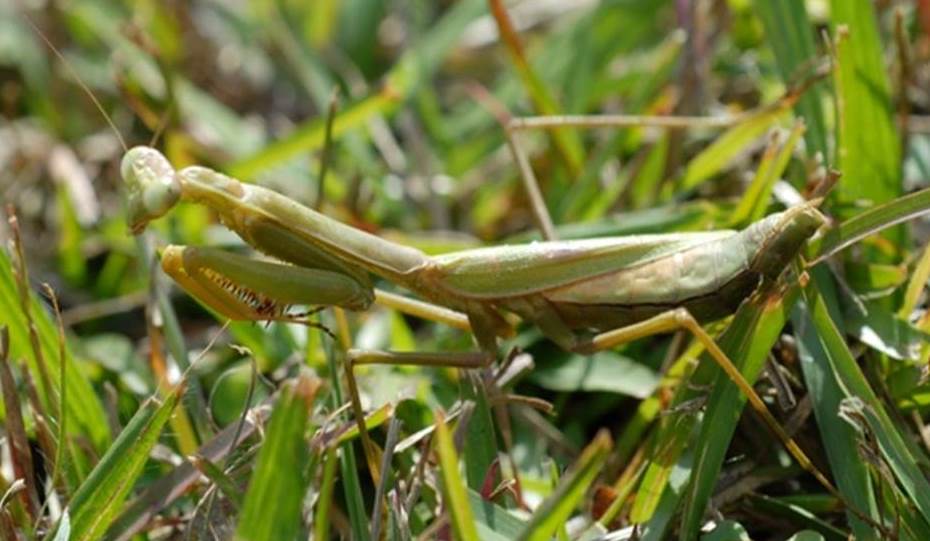
by Les Harrison | Jul 14, 2017

Praying Mantis, Image Credit Les Harrison
Summertime is bug time in the Florid Panhandle. The weather has provided enough rain for the bugs which depend on a supply of foliage and the temperatures have been ideal for a population explosion.
Stink bugs, leaf-footed bugs, grasshoppers, all sizes and colors of caterpillars and many more have been enjoying the lush and plentiful dining options. More than one Panhandle homeowner or gardener has been plagued by the sudden appearance of a hoard of hungry nuisances which are eyeing the menu choices at residences.
Fortunately, nature has a way of eventually balancing all situations when left to its own devices. With the increase of the plant eaters comes a surge in those insects which restrain the excess population.
One of the most easily recognized predator insects is the praying mantis. This beneficial insect is actually a family with multiple members, some of which have been introduced to Florida.
While there are over 2400 mantis members worldwide, Florida is home to eleven. Two of those exotics have been introduced from other regions, but considered non- invasive.
Mantises are thought to have evolved during the Cretaceous period about 100 million years ago, possibly from a predatory cockroach with similar front legs. Their closest surviving insect relatives are cockroaches and termites, both of which they will consume if given the opportunity.
Like many insects, the mantis is equipped with a tough, durable exoskeleton which provides a basis for successful close quarter combat and meal procurement. These hunters have three other advantages which create a severe vulnerability in their prey’s defense and potential for surviving a mantis encounter.
The mantis is an ambush predator which will lay in wait for the victim/meal to deliver itself. The mantis has the instinctive ability to identify and hide in areas with high amounts of prey species traffic.
This insect is a master at stealth and camouflage. The creature’s coloration and linear shape allow it to blend into the earth tones of many settings.
To complement its ability to conceal itself in plain sight, the mantis can hold perfectly still and patiently wait for the oblivious bug to bumble into sticking range. At that precise moment, the mantis is a blur of lethal motion.
The mantis’ forelimbs are a set of deadly spiked vices used to immobilize and secure its target. It extends these spiny levers forward in a raised position which appears as though it is in a mealtime prayer, hence its name.
The kill technique is to impale and restrain the victim with a single stroke of the forelimbs while holding the victim securely to the mantis’ body. On occasion the attempt fails and the mantis has to apply a more direct approach.
This insect’s beak is designed for slicing and tearing its victim’s body. Its jaw muscles provide the power to effectively employ this tool.
Depending on its stage of live, the mantis will eat a wide variety of creatures. Early stage mantises will eat little flies and other tiny insect (including its siblings), but at maturity they will take on small reptiles and amphibians along with a variety of destructive insects.
Female mantises will even consume their prospective mates. Despite its vicious and cannibalistic nature, the praying mantis is the answer to many gardeners’ prayers.
To learn more about praying mantises and other beneficial insects, check out this EDIS site with many articles on various species of beneficial insects.

by Julie McConnell | Jul 12, 2017

Coontie (Zamia floridana) planted at the same time but growing at different rates. Photo: J_McConnell, UF/IFAS
When designing landscapes, it is popular to create lines and masses of plants for high visual impacts. Plants are carefully selected to be similar in size and shape at the time of installation. They are all grouped together, so they must be getting the same care, but why do they look different years later? There are several factors to consider when we are trying to figure out why a perfectly matched set no longer looks like a uniform planting.
Although plants may be in the same bed, shadows cast at certain times of the day may reduce sunlight to some sections and not others. This can be caused by structures or trees that have grown over time and changed light patterns.
Supplemental irrigation may also be variable even with the best system design. Over time plants grow and may block sprinkler emitters from reaching some sections of landscape beds. Even if the landscape relies on natural rainfall, there can be still be dry/wet spots in the landscape due to drainage off of hard structures, low areas, or wind direction during storms.
It might be possible to adjust some lighting and watering issues, but there is one factor that many gardeners have not considered – genetics. If plants were grown from seed, than variation is not only possible, but likely. This might be displayed as differences in height and width, foliage color, flower color, speed of growth – all may be influenced by parentage despite best efforts to care for each plant similarly.
Many landscape plants are cultivars. This means they are grown from cuttings or divisions which make them identical to the original plant. When a plant is grown from seed, however, there is no guarantee it will have the same specific qualities as the mother plant.
To combat this phenomenon, landscapers should check sunlight and watering for irregular growth patterns and adjust if needed. If a landscape design requires uniform plants, use named cultivars rather than seedling grown plants in lines or masses.










